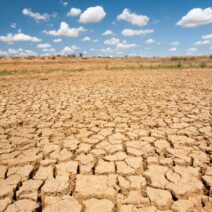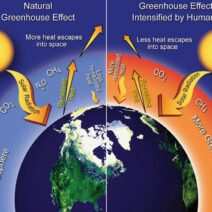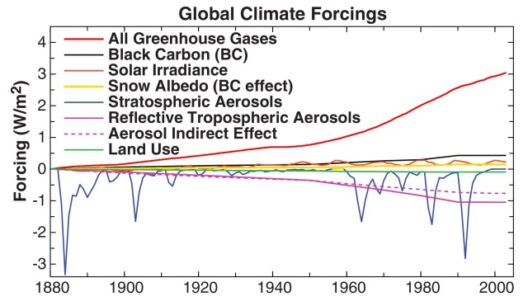Global warming, an increasingly prominent issue, raises numerous questions about the fundamental principles governing our universe. Among these inquiries, one tantalizing question stands out: does global warming violate the laws of thermodynamics or Henry’s Law? Understanding this complex relationship necessitates a deep dive into both the thermodynamic laws and Henry’s Law, contextualized within the contemporary challenges posed by climate change.
At its core, the laws of thermodynamics describe the relationships between energy, heat, and work, fundamentally governing the principles of energy conservation and entropy. The first law asserts that energy cannot be created or destroyed, only transformed. This principle can be readily seen in the context of Earth’s climate system, where solar energy is converted to heat through the greenhouse effect. The greenhouse gases trap this heat, leading to temperature increases, but do not create energy. Therefore, the first law remains intact despite the alarming trends in global temperatures.
The second law of thermodynamics posits that in any energy transfer, some amount of energy becomes disordered or unavailable for work, leading to increased entropy. An often-cited misconception is that global warming contradicts this law. However, what is pivotal to understand is that the planet’s energy balance is a dynamic system. Incoming solar radiation drives the system, while outgoing longwave radiation must adjust accordingly. The surplus trapped by greenhouse gases indeed exacerbates entropy, but it does not contravene the second law; rather, it underscores the complex interactions within Earth’s energy systems.
For example, the accumulation of greenhouse gases like carbon dioxide and methane creates a feedback loop exacerbating climate change. As temperatures rise, ice melts, which reduces the Earth’s albedo—the reflection of solar radiation. Darker ocean waters absorb more heat, further contributing to warming. This cascading effect illustrates how energies are redistributed rather than violating thermodynamic principles.
Conversely, Henry’s Law is relevant in discussions around the solubility of gases in liquids under varying conditions. Specifically, it delineates how the concentration of a gas in a liquid at equilibrium relates to the partial pressure of that gas above the liquid. As the Earth’s atmosphere warms due to increased greenhouse gas concentrations, the ocean’s capacity to hold dissolved gases, notably carbon dioxide, diminishes. This relationship presents a significant risk; as warmer waters can hold less CO2, the oceans may release this gas back into the atmosphere, further compounding atmospheric levels and exacerbating global warming.
Upon deeper examination, it becomes evident that the intricate choreography between the laws of thermodynamics and Henry’s Law does not imply a violation of either concept. On the contrary, they coexist, illustrating profound implications of climate change on both terrestrial and aquatic systems. The increasing temperature influences gas solubility and drives chemical reactions, resulting in shifts in biodiversity and ecosystem health. Marine life, for instance, is particularly vulnerable as acidified waters disrupt the balance needed for survival, significantly impacting species such as corals and shellfish.
One might argue that the patterns emerging today, such as extreme weather events, might suggest deviations from the expected scientific narratives, posing challenging questions about our understanding. However, they are consistent with climatic shifts predicted by the laws of thermodynamics. The interconnection of these complex systems is not merely a matter of theoretical interest; it has tangible, consequential effects on the environment. The realities of continued fossil fuel consumption and deforestation lead to significant increases in greenhouse gas emissions, which radically change earth’s energy dynamics.
Addressing climate change in a manner rooted in scientific principles affords us a framework to challenge misconceptions. It empowers us to advocate for sustainable practices that align more harmoniously with nature’s laws. For example, transitioning to renewable energy sources harnesses solar, wind, and geothermal energies, creating a sustainable and affordable energy future where the equilibrium of thermodynamic laws can be respected and utilized for advantageous purposes.
Furthermore, enhancing carbon capture technologies presents a plausible avenue to mitigate the impacts of global warming. By capturing CO2 emissions before they enter the atmosphere, technologies can recycle the carbon within a closed system, allowing for innovative approaches to achieve carbon neutrality while adhering to the laws of thermodynamics. In this way, humanity can control the entropy of carbon emissions, thus allowing for a more balanced interaction with Earth’s climate system.
Integration of scientific insights into policy-making on a global scale is paramount. Effective climate action must take into account these principles and acknowledge the interconnectedness of atmospheric, terrestrial, and oceanic systems. Policies that promote local resilience, foster community engagement in sustainability practices, and advocate for scientific literacy will be crucial in combating climate change’s threats. International agreements, such as the Paris Accord, serve as frameworks for collaboration, emphasizing the necessity of collective action rooted in scientific understanding.
In conclusion, the phenomena observed in the context of global warming do not contravene the established laws of thermodynamics or Henry’s Law. Rather, they illuminate the complexities of our climate system and the profound challenges we face. By embracing these principles, we can develop informed strategies to combat climate change, engage in dialogue, and foster an eco-conscious society, ensuring a healthier planet for future generations. The urgency of recognition and action transcends mere comprehension; it encapsulates a collective responsibility to steward Earth’s ecosystems wisely.







